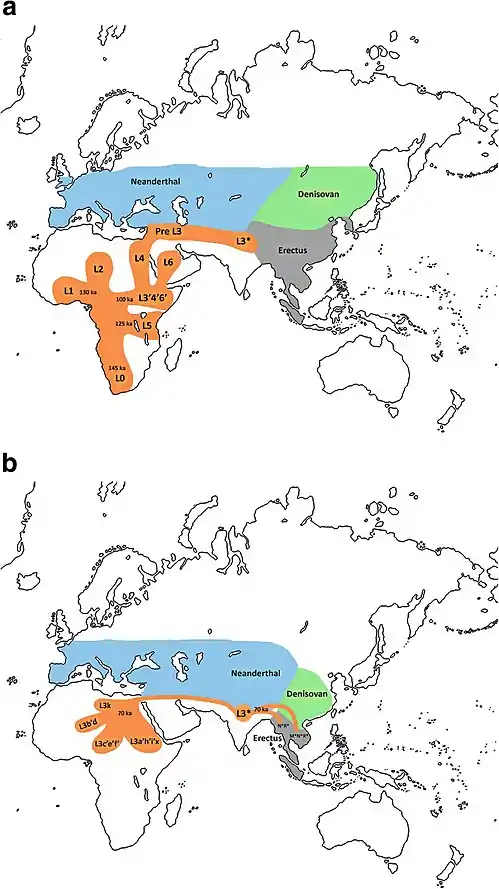Haplogruppe L3
Die Haplogruppe L3 ist in der Humangenetik eine Haplogruppe der Mitochondrien. Zur Haplogruppe L3 sind die Forscher der Ansicht, dass sie vor 84.000 bis 104.000 Jahren entstand[4].
| Haplogruppe der mitochondrialen DNA | |
|---|---|
| Name | L3 |
| Mögliche Ursprungszeit | vor 84.000 bis 104.000 Jahren |
| Möglicher Ursprungsort | Ostafrika oder Asien[1] |
| Vorgänger | L3'4 |
| Nachfolger | L3a, L3b'c'd'j, L3e'i'k'x, L3f, L3h, M, N |
| Mutationen | 769, 1018, 16311 |




Sie ist vor allem in Ostafrika verbreitet, im Gegensatz zum Subsahara-Afrika, wo die Haplogruppen L1 und L2 rund zwei Drittel der mtDNA-Haplogruppen ausmachen[5].
L3 ist unterteilt in mehrere Untergruppen, eine davon hat die Makrohaplogruppen M und N hervorgebracht, von denen die meisten Nichtafrikaner abstammen.
Nach Maca-Meyer et al. (2001): „Haplogruppe L3 ist stärker mit eurasischen Haplogruppen verwandt als die divergierenden afrikanischen Cluster L1 und L2“[6].
Stammbaum
Dieser phylogenetische Stammbaum der Subgruppen von Haplogruppe L3 basiert auf einer Veröffentlichung von Mannis van Oven und Manfred Kayser[7] und anschließender wissenschaftlicher Forschung.
- L3'4
- L3
- L3a
- L3b'c'd'j
- L3b
- L3b1
- L3b1a
- L3b1a1
- L3b1a2
- L3b1b
- L3b1b1
- L3b1a
- L3b2
- L3b1
- L3c
- L3d
- L3d1-5
- L3d1
- L3d1a
- L3d1a1
- L3d1a1a
- L3d1a1
- L3d1b
- L3d1b1
- L3d1c
- L3d1d
- L3d1a
- L3d2
- L3d3
- L3d3a
- L3d4
- L3d5
- L3d1
- L3d1-5
- L3j
- L3b
- L3e'i'k'x
- L3e
- L3e1
- L3e1a
- L3e1a1
- L3e1a1a
- L3e1a2
- L3e1a3
- L3e1a1
- L3e1b
- L3e1c
- L3e1d
- L3e1e
- L3e1a
- L3e2
- L3e2a
- L3e2b
- L3e2b1
- L3e2b2
- L3e3'4'5
- L3e3'4
- L3e3
- L3e3a
- L3e3b
- L3e4
- L3e3
- L3e5
- L3e3'4
- L3e1
- L3i
- L3i1
- L3i1a
- L3i1b
- L3i2
- L3i1
- L3k
- L3x
- L3x1
- L3x2
- L3x2a
- L3x2a1
- L3x2a1a
- L3x2a1
- L3x2b
- L3x2a
- L3e
- L3f
- L3f1
- L3f1a
- L3f1b
- L3f1b1
- L3f1b2
- L3f1b3
- L3f1b4
- L3f1b4a
- L3f1b4a1
- L3f1b4a
- L3f2
- L3f2b
- L3f3
- L3f1
- L3h
- L3h1
- L3h1a
- L3h1a1
- L3h1a2
- L3h1a2a
- L3h1a2b
- L3h1b
- L3h1b1
- L3h1b1a
- L3h1b1
- L3h1a
- L3h2
- L3h1
- M
- N
- L3
Einzelnachweise
- https://www.biorxiv.org/content/10.1101/233502v1
- Vicente M. Cabrera, Patricia Marrero, Khaled K. Abu-Amero, Jose M. Larruga: Carriers of mitochondrial DNA macrohaplogroup L3 basal lineages migrated back to Africa from Asia around 70,000 years ago. In: BMC Evolutionary Biology. Band 18, Nr. 1, 19. Juni 2018, ISSN 1471-2148, S. 98, doi:10.1186/s12862-018-1211-4, PMID 29921229, PMC 6009813 (freier Volltext).
- Vai S, Sarno S, Lari M, Luiselli D, Manzi G, Gallinaro M, Mataich S, Hübner A, Modi A, Pilli E, Tafuri MA, Caramelli D, di Lernia S: Ancestral mitochondrial N lineage from the Neolithic 'green' Sahara. Sci Rep. 9 (March 2019) (1): 3530.
- Sarah A. Tishkoff et al.: Whole-mtDNA Genome Sequence Analysis of Ancient African Lineages. In: Molecular Biology Evolution, Bd. 24 (2007), Heft 3, S. 757–768, ISSN 0737-4038.
- Douglas C. Wallace et al.: Origin of haplogroup M in Ethiopia. In: American Journal of Human Genetics, Bd. 67 (2000), Supplement, S. 217, ISSN 0002-9297.
- Nicole Maca-Meyer et al.: Major genomic mitochondrial lineages delineate early human expansions. In: BMC Genetics, Bd. 2 (2001), S. 13, ISSN 1471-2156.
- Mannis van Oven, Manfred Kayser: Updated comprehensive phylogenetic tree of global human mitochondrial DNA variation. In: Human Mutation. 30, 2009, S. E386, PMID 18853457. doi:10.1002/humu.20921.
Webseiten
- Biologiezentrum Österreich zu Haplogruppe L3 (Memento vom 23. April 2008 im Internet Archive)
| Evolutionsbaum Haplogruppen Mitochondriale DNA (mtDNA) | ||||||||||||||||||||||||||||||||||||||||||||||||||||||||||||||||||||||||||||||||||||||||||||||||||||||||||||||||||
|---|---|---|---|---|---|---|---|---|---|---|---|---|---|---|---|---|---|---|---|---|---|---|---|---|---|---|---|---|---|---|---|---|---|---|---|---|---|---|---|---|---|---|---|---|---|---|---|---|---|---|---|---|---|---|---|---|---|---|---|---|---|---|---|---|---|---|---|---|---|---|---|---|---|---|---|---|---|---|---|---|---|---|---|---|---|---|---|---|---|---|---|---|---|---|---|---|---|---|---|---|---|---|---|---|---|---|---|---|---|---|---|---|---|---|
| ||||||||||||||||||||||||||||||||||||||||||||||||||||||||||||||||||||||||||||||||||||||||||||||||||||||||||||||||||